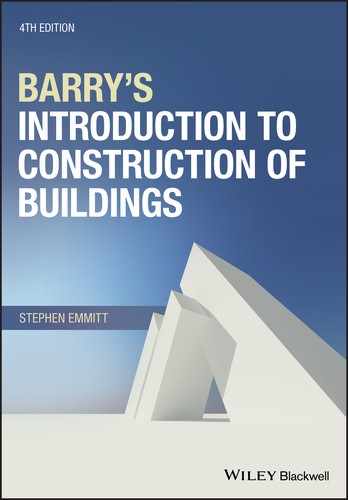Preface
Robin Barry’s Construction of Buildings first appeared in print in 1958 and eventually grew into five volumes. When I took on the task of revising and updating the Barry books, a decision was taken to condense the work into two volumes to make it more accessible to readers. This was a big task, and it required the input of a former colleague, Christopher Gorse, and the help of many individuals and companies, for which I remain extremely grateful.
Working on the books continues to be a process of addition and subtraction to keep the content topical and informative to a wide readership. Now, as a solo‐authored work, it has been possible to further simplify and clarify the content while making the latest round of revisions. This has resulted in repositioning of material and new features, such as ‘How to navigate this book’ and the ‘At a glance’ fact sheets. The repositioning of material, from one volume to another, and within volumes, has helped to ensure a more logical flow of information that better reflects the process of construction. The main changes to each volume are as follows.
This volume has retained the same chapter structure, with changes made within chapters to improve readability. The introductory chapter has been rewritten to better explain the process of construction and to place greater emphasis on its environmental impact. The material on timber‐framed construction has been moved to the Advanced volume, which has allowed for simplification, rewriting and renaming of Chapter 5 to better reflect the content on loadbearing wall construction. Scaffolding can now be found in this volume, and the material on foundations has been restructured in both volumes to remove repetition.
The Advanced volume has been restructured. Offsite construction has been rewritten and moved to the front of the book (Chapter 2), since most of the material in the volume is concerned with prefabricated and preassembled construction. There is a new chapter on framed timber construction (Chapter 5); thus, the three main materials for framed construction – timber, concrete and steel – are now in the same volume, making it easier for readers to draw comparisons. The material relating to existing buildings, demolition and recycling has been moved to Chapter 11, thereby completing the entire building lifecycle.
In making these revisions, the original philosophy of Robin Barry – to address the functional requirements of building elements – has been retained. Regardless of building type, the functional requirements of the main elements remain relevant. Similarly, the underpinning construction principles remain much the same, despite ever changing building codes, regulations, guidance and better awareness of the environmental impact of buildings.
Professor Stephen Emmitt
Department of Architecture and Civil Engineering
University of Bath, UK
